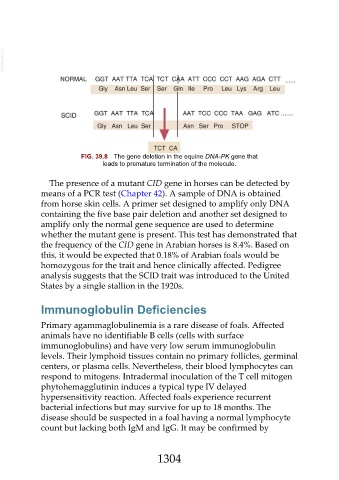Page 1304 - Veterinary Immunology, 10th Edition
P. 1304
VetBooks.ir
FIG. 39.8 The gene deletion in the equine DNA-PK gene that
leads to premature termination of the molecule.
The presence of a mutant CID gene in horses can be detected by
means of a PCR test (Chapter 42). A sample of DNA is obtained
from horse skin cells. A primer set designed to amplify only DNA
containing the five base pair deletion and another set designed to
amplify only the normal gene sequence are used to determine
whether the mutant gene is present. This test has demonstrated that
the frequency of the CID gene in Arabian horses is 8.4%. Based on
this, it would be expected that 0.18% of Arabian foals would be
homozygous for the trait and hence clinically affected. Pedigree
analysis suggests that the SCID trait was introduced to the United
States by a single stallion in the 1920s.
Immunoglobulin Deficiencies
Primary agammaglobulinemia is a rare disease of foals. Affected
animals have no identifiable B cells (cells with surface
immunoglobulins) and have very low serum immunoglobulin
levels. Their lymphoid tissues contain no primary follicles, germinal
centers, or plasma cells. Nevertheless, their blood lymphocytes can
respond to mitogens. Intradermal inoculation of the T cell mitogen
phytohemagglutinin induces a typical type IV delayed
hypersensitivity reaction. Affected foals experience recurrent
bacterial infections but may survive for up to 18 months. The
disease should be suspected in a foal having a normal lymphocyte
count but lacking both IgM and IgG. It may be confirmed by
1304

